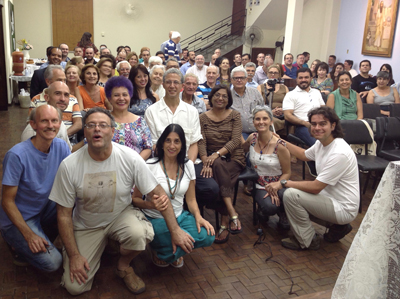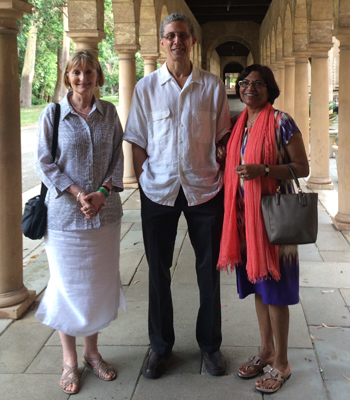Printed in the Summer 2016 issue of Quest magazine.
Citation: Boyd, Tim, "President’s Diary" Quest 104.3 (Summer 2016): pg. 130-131
Shortly after the close of our convention at Adyar in January, it was off to Australia for their annual convention. The site for the event rotates
| Tim and Lily Boyd with Linda Oliveira (left), president of the Australian Section |
among the various centers in the country. This year it was in Perth, on the far west side of the continent. This was my first time in Australia, and it gave me some perspective on the size of the country when I met so many Australians who, like me, were coming to Perth for the first time. I sometimes forget that Australia is not just a country, but a continent.
The Australian Section is one of the more active and organized sections in the TS world. The theme for this year’s gathering was “Today’s World Problems: Insights from the Wisdom Tradition” and was held on the beautiful campus of the University of Western Australia, right on the Swan River. During our time there, the members from the host branch in Perth brought the whole group out for a tour of the city that ended with tea at their building.
From Australia it was back to the U.S. for a total of eight days before leaving for a much-anticipated visit to Brazil. For the past several years in February, at the time of the massive national celebration of Carnaval, a group of Brazilian Young Theosophists (YTs) have held a multiday get-together at the Instituto Teosófica outside of Brasília. At last year’s meeting of the TS General Council I made the point that whenever I visit a national section I would like to have a separate meeting with young members only. In Italy, Finland, the Netherlands, India, and Singapore we had such meetings. When the Brazilian YTs heard this, they did two things: first, they invited me to attend their annual gathering; second, they made it an international YT meeting. Members from around the world were invited. Because the cost of international travel for young members can be prohibitive, we asked our national sections to help when possible. The result was a group of 75 YTs, predominantly from Brazil, but also coming from Italy, the Netherlands, England, Mexico, Spain, and Argentina.
As you might expect, it was a high-energy program that spanned day and night. One of the beauties of the meeting was that every aspect of it was planned and executed by the young members—everything from the daily schedule to picking up participants at the airport. Because it is not every day that the international president visits Brazil, a number of “older” members wanted to attend the program. This created a minor problem. The YTs were not trying to discriminate against us old ones, but everyone knew that open enrollment would change the character and intent of the meeting. A solution was found by scheduling me to speak on a couple of evenings at the branch in Brasília.
The meeting was a huge success. In addition to talks and panels, there was music, campfires, tree planting, and swimming in some of the more than thirty waterfalls that dot the land of the Instituto. Friendships were formed that will last into the future. The group decided that they will do it again next year. Get ready.
From Brasília it was on to Rio de Janeiro. With its setting of mountains, ocean, and beaches, it is arguably one of the most beautiful cities on earth. During our brief visit we kept a busy schedule with public and members’ meetings at the local branch, a radio interview with TS member and radio personality Fernando Mansur, and meetings with local members.
 |
|
Tim and Lily Boyd (at center)at a public talk in São Paulo
|
Next on the tour was São Paulo—a huge city of 20 million people and Brazil’s economic hub. The TS has a little oasis at its Pitagoras (Pythagoras) Theosophical Institute in the downtown area. It is a lovely site, with multiple meeting areas, office, and a courtyard garden. On the evening we arrived I gave a talk to around 100 members from the area. Immediately following the talk, we got into the car to travel to the Raja Center outside of the city. Just to give you some idea about the scale of a city of 20 million people: it took almost two hours just to get out of the city.
The next three days were spent at the Raja Center in the countryside on the outskirts of town. The center is named for past TS international president and author C. Jinarajadasa (Brother Raja), who felt that he had a special past-life connection with Brazil. The center is a gated compound of several acres with a meeting hall, library, dining area, and dormitories. About fifty members attended the program on the TS’s Three Objects. While there, I was told that I am the chair of its board of directors. The things you learn when you travel . . .
We arrived back in the U.S. in time for our TSA board of directors’ meeting. Twice a year, in February and July, the board meets for three and a half days to go over the TSA’s business and to plan for the future. Immediately following the close of the TSA board meeting, the Theosophical Order of Service (TOS) board meeting begins. Our TOS-USA president, Nancy Secrest, currently also wears the hat of TOS international secretary. She is a busy lady these days.
At the end of February I attended an art exhibit in Chicago at the Stony Island Art Bank (reviewed in Quest, spring 2016). The show was titled “Intention to Know: The Thought Forms of Annie Besant.” The curator for the show was Carolyn Christov-Bakargiev—the same person who put together last year’s Istanbul Biennial show, “SaltWater,” which also gave prime consideration to the Thought Forms paintings.
In March it was off to Mexico and Argentina. In Mexico I participated in the first North American meeting of the Inter-American Federation. It was held in the small city of Cholula. The city rests in the shadow of the active volcano Popocatépetl. Members came from a number of countries—Mexico, Costa Rica, Brazil, Honduras, Puerto Rico, the U.S., and a couple more that I am forgetting. It was a high-energy meeting, whose theme was “Applying the Principles of the Ageless Wisdom.”
Next stop: Buenos Aires, Argentina—for one day. In Buenos Aires we had not scheduled an official meeting. The local members got together at the building the TS owns just outside of downtown. I had a chance to talk informally with the members. It was an active conversation with plenty of give-and-take. It was also good to see again the group of members who had come to Adyar for this year’s convention.
The next morning we were on the plane, the one flight a day that comes and goes to San Rafael. Back in the 1970s there was a movement in the TS in Argentina to build a Theosophical center—a community. There was a strong group in San Rafael which found and acquired a several acre plot of land in 1980. San Rafael is in a semiarid location, and at the time the property was purchased there was a grand total of three trees on the land. Today there are hundreds. TS member and civil engineer Juan Carlos Palmeri helped design a plan of construction that included five long buildings in the pattern of a star. To date four have been constructed, which include two dormitories, a meeting hall and quiet space, and a building for dining.
The occasion for our visit was the third annual Luso-Hispanic (Portuguese-Hispanic) meeting. About seventy-five members from countries all over Latin America attended. Actually, I had participated in the first one at the Instituto in Brasília in 2013. The visit began with an interview for the local TV station, then an evening public talk at the local university. The next few days involved meetings of all types—lectures, meetings with heads of sections, one on one meetings, and, of course, some sightseeing.
Back in the U.S., the kids from the Prairie School of DuPage did a follow-up presentation on the health of Perkins Pond on the Olcott property. For those of you who are reading this diary for the first time, or who have a short memory, the Prairie School is an alternative schooling project that began in 2011. When I first came in as TSA president, members of the fledgling school approached me about possibly setting up shop with us. Their nature-based system, the core values of the school, and their educational rigor made the choice something of a no-brainer. Both teachers and kids love and know every inch of our forty-two acre campus. Since coming to Olcott, they had observed that the health of our Perkins Pond was not ideal and had set up a project to test the waters and study it. Last year they gave a presentation setting out some suggestions for remediation. This year they came back with a conclusive follow-up study. Before, they had identified several possible causes for the decline in the pond’s health. This time their year-long study narrowed it down to one cause—geese. It turns out that the lovely and very scenic presence of Canada geese is altering the chemical balance of the pond because of “goose poop.” The solution? Plant tall grasses and other nitrogen-fixing plants around the pond. Geese are wary of tall plants, where they cannot see possible predators like coyotes hiding.
We’ll keep you posted.
Tim Boyd


